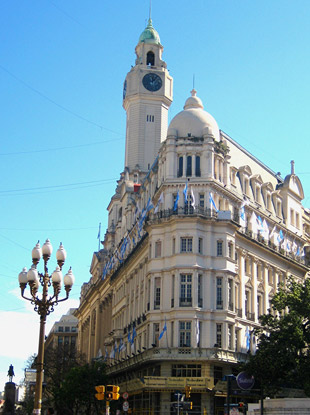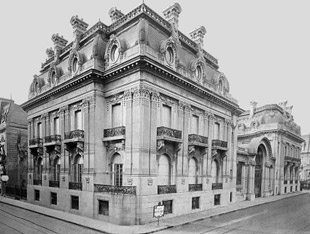Legislative Palace of the City of Buenos Aires
 By the first decades of the 20th century, Argentina ranked among the richest countries in the world. This amazing progress was set in motion by the Generation of the ‘80s, statesmen determined to build a replica of modern Europe in Argentina with Buenos Aires symbolizing this dream. It's not surprising that many of the buildings constructed in Argentina during the last decades of the 19th century and in the early 20th century looked to European models for inspiration. The Legislative Palace in the city of Buenos Aires is but one example. Designed by Héctor Ayerza (1893-1949), who trained in Buenos Aires and France, it was built between 1927 and 1931 in Louis XIV neoclassical style. The heart of the building is the Sessions Chambers and its many sumptuous salons. The Salon Dorado (Golden Salon), inspired by the Palace of Versailles and specifically the Gallery of Mirrors, is perhaps the most famous of these salons.
By the first decades of the 20th century, Argentina ranked among the richest countries in the world. This amazing progress was set in motion by the Generation of the ‘80s, statesmen determined to build a replica of modern Europe in Argentina with Buenos Aires symbolizing this dream. It's not surprising that many of the buildings constructed in Argentina during the last decades of the 19th century and in the early 20th century looked to European models for inspiration. The Legislative Palace in the city of Buenos Aires is but one example. Designed by Héctor Ayerza (1893-1949), who trained in Buenos Aires and France, it was built between 1927 and 1931 in Louis XIV neoclassical style. The heart of the building is the Sessions Chambers and its many sumptuous salons. The Salon Dorado (Golden Salon), inspired by the Palace of Versailles and specifically the Gallery of Mirrors, is perhaps the most famous of these salons.
The building, with its triangular plan, is recognized from a distance by its approximately 310-foot (95 meters) clock tower. There are five large bells associated with the clock and a carillon of 30 bells, each with a distinct tone for more complex music. The main part of the building, consisting of a ground floor and five stories, is a rich composition of many traditional architectural elements. Soaring Corinthian columns mark the entrance, and at the top floor, the exterior of the building is decorated with 26 statues representing such concepts as the city, social order, justice, vigilance, and many other themes associated with knowledge and industry, such as music, history, commerce, and agriculture.
The official ceremony for the 2009 Pritzker Architecture Prize is held in this landmark.
Read Peter Zumthor's Ceremony Acceptance Speech
Read Tom Pritzker's Ceremony Speech
 Originally the Palacio Anchorena, Palacio San Martin was purchased by the Ministry of Foreign Relations in 1936 and named in honor of José de San Martín, the leader of the independence of Argentina. Designed in 1906 by architect Alejandro Christophersen (1866-1946), it was conceived as a “hotel particular,” containing three residences organized around a central patio. The architecture, as in many residences of wealthy Argentine families at that time, is historicist eclecticism, and in the early years of the 20th century, the influence was clearly French. It combines organizational elements of classicism along with the lyricism of Art Nouveau. The architect, whose father was in the Norwegian diplomatic corps, was born in Spain, trained in Paris and Antwerp, and settled in Argentina soon after completing his studies. In an almost sculptural way, the Palacio combines convex mansards, cupolas, chimneys, columns, and balconies. The central patio or cour d’honeur has an impressive double staircase that led to the individual residences. In addition to the famous Palacio San Martin, Alejandro Christophersen designed other notable residences, hotels, banks, and offices and is also known for his paintings, teaching, and writings.
Originally the Palacio Anchorena, Palacio San Martin was purchased by the Ministry of Foreign Relations in 1936 and named in honor of José de San Martín, the leader of the independence of Argentina. Designed in 1906 by architect Alejandro Christophersen (1866-1946), it was conceived as a “hotel particular,” containing three residences organized around a central patio. The architecture, as in many residences of wealthy Argentine families at that time, is historicist eclecticism, and in the early years of the 20th century, the influence was clearly French. It combines organizational elements of classicism along with the lyricism of Art Nouveau. The architect, whose father was in the Norwegian diplomatic corps, was born in Spain, trained in Paris and Antwerp, and settled in Argentina soon after completing his studies. In an almost sculptural way, the Palacio combines convex mansards, cupolas, chimneys, columns, and balconies. The central patio or cour d’honeur has an impressive double staircase that led to the individual residences. In addition to the famous Palacio San Martin, Alejandro Christophersen designed other notable residences, hotels, banks, and offices and is also known for his paintings, teaching, and writings.